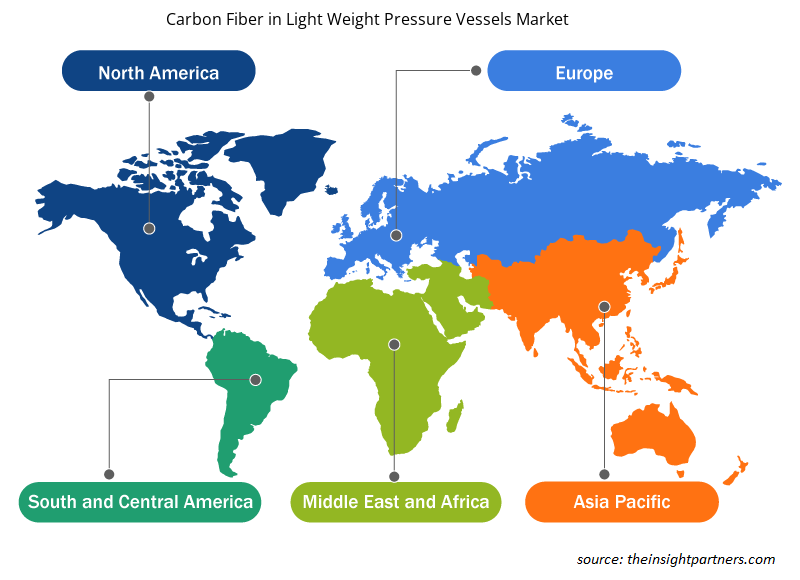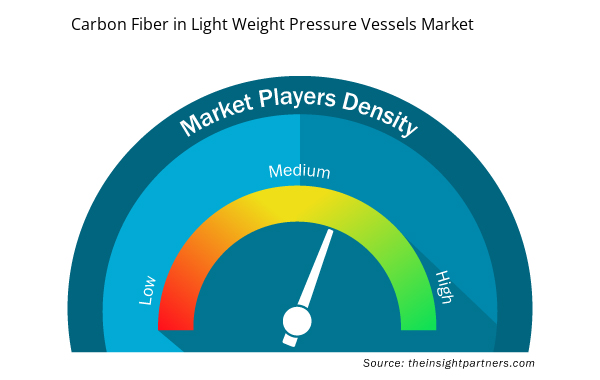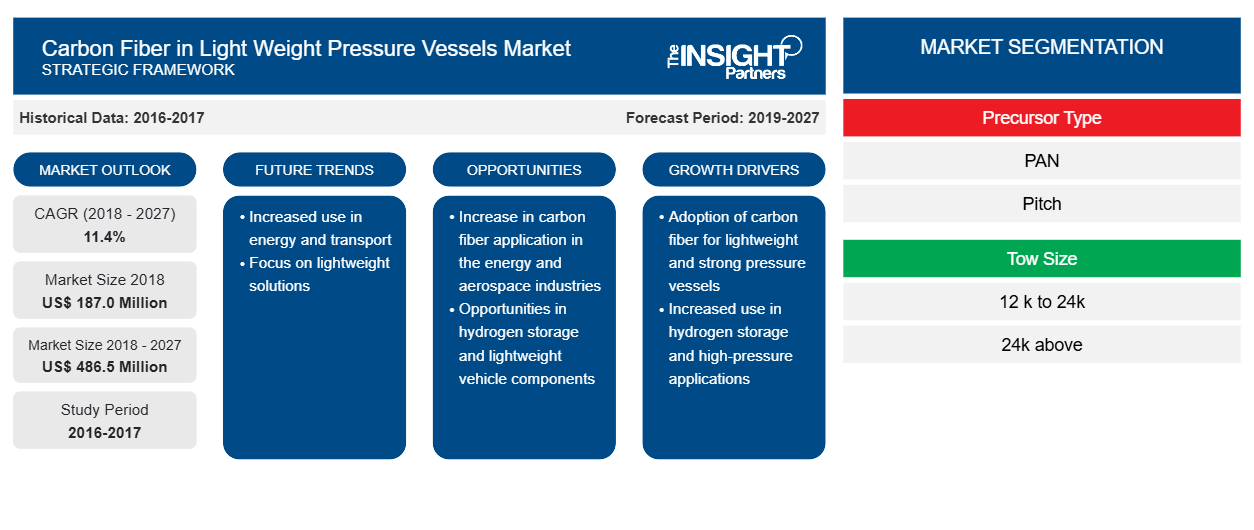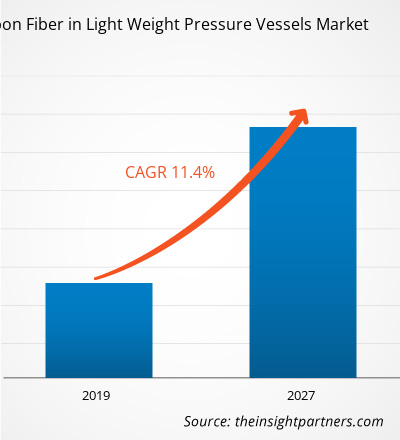2018 年全球轻型压力容器碳纤维市场规模为 1.87 亿美元,预计在 2019 - 2027 年预测期内复合年增长率为 11.4%,到 2027 年将达到 4.865 亿美元。
亚太地区是碳纤维压力容器增长最快的地区,这归因于印度、中国和日本等国人口不断增长、政府对环境问题的日益关注,以及对节能环保的 CNG 汽车的日益关注。此外,汽车行业日益增长的需求也有望推动该地区轻型压力容器市场中碳纤维的增长。
市场洞察
汽车和工业应用需求的不断增长为碳纤维在轻质压力容器市场的增长提供了机会
碳纤维具有高模量和比强度、高疲劳强度、高刚度、高耐压能力、较低的热膨胀系数、耐腐蚀性和其他有益特性,使其可用于汽车和其他工业应用的压力容器。此外,轻质材料的需求不断增长,以及政府减少有害气体排放和提高燃油效率的举措,预计将推动碳纤维在汽车应用的轻质压力容器市场的发展。
定制此报告以满足您的需求
您可以免费定制任何报告,包括本报告的部分内容、国家级分析、Excel 数据包,以及为初创企业和大学提供优惠和折扣
- 获取此报告的关键市场趋势。这个免费样品将包括数据分析,从市场趋势到估计和预测。
燃料电池汽车中碳纤维压力容器的应用日益广泛,将为全球轻质压力容器市场碳纤维创造增长机会
预计全球轻型压力容器市场对用于储存高压氢气的密封容器中碳纤维的需求将不断增长。碳纤维被认为是生产可靠、安全压力容器的最佳选择,因为它具有承受氢气高压的能力,因此全球汽车制造商越来越多地参与燃料电池汽车的开发,各国政府也为燃料电池汽车的生产提供基础设施建设支持。
前体洞察
根据前体,全球轻型压力容器用碳纤维市场细分为聚丙烯腈 (PAN) 和沥青。聚丙烯腈 (PAN) 部分引领了全球轻型压力容器用碳纤维市场。聚丙烯腈 (PAN) 是一种含碳量约为 68% 的碳纤维,是碳纤维最广泛使用的前体之一。PAN 由丙烯腈 (AN) 通过聚合工艺通过常用的抑制剂(例如偶氮化合物和过氧化物)聚合而成。轻型压力容器对碳纤维的需求不断增长,导致 PAN 的制造和生产激增,因为它是最广泛使用的前体之一。
拖车尺寸洞察
全球轻型压力容器用碳纤维市场按丝束尺寸分为 12k 至 24k 和 24K 以上。12k 至 24k 部分在全球轻型压力容器用碳纤维市场中占有最大份额。12k 至 24k 丝束尺寸碳纤维的厚重和坚硬特性在军事和科学设备应用中非常有用,这是促进全球 12K 至 24K 丝束尺寸碳纤维增长和扩张的主要因素。生产 12K 至 24K 碳纤维的一些主要关键参与者包括东丽复合材料美国公司、帝人有限公司、西格里集团等。
轻型压力容器中的碳纤维市场区域洞察
Insight Partners 的分析师已详细解释了预测期内影响轻型压力容器碳纤维市场的区域趋势和因素。本节还讨论了北美、欧洲、亚太地区、中东和非洲以及南美和中美洲的轻型压力容器碳纤维市场细分和地理位置。

- 获取轻型压力容器市场中碳纤维的区域特定数据
碳纤维在轻型压力容器中的应用市场报告范围
| 报告属性 | 细节 |
|---|---|
| 2018 年市场规模 | 1.87 亿美元 |
| 2027 年市场规模 | 4.865亿美元 |
| 全球复合年增长率(2018 - 2027) | 11.4% |
| 史料 | 2016-2017 |
| 预测期 | 2019-2027 |
| 涵盖的领域 | 按前驱体类型
|
| 覆盖地区和国家 | 北美
|
| 市场领导者和主要公司简介 |
|
市场参与者密度:了解其对商业动态的影响
轻型压力容器市场中的碳纤维市场正在快速增长,这得益于最终用户需求的增加,这些需求是由于消费者偏好的不断变化、技术进步以及对产品优势的认识不断提高等因素所致。随着需求的增加,企业正在扩大其产品范围,进行创新以满足消费者的需求,并利用新兴趋势,从而进一步推动市场增长。
市场参与者密度是指在特定市场或行业内运营的企业或公司的分布情况。它表明在给定市场空间中,相对于其规模或总市场价值,有多少竞争对手(市场参与者)存在。
在轻型压力容器碳纤维市场运营的主要公司有:
- 晓星株式会社
- 索尔维
- 台塑股份有限公司
- 东丽株式会社
- 帝人株式会社
免责声明:上面列出的公司没有按照任何特定顺序排列。

- 了解轻型压力容器中碳纤维市场的主要参与者概况
并购、投资方案、新产品开发等被视为全球轻质压力容器碳纤维市场最常采用的策略。以下列出了全球轻质压力容器碳纤维市场的一些最新发展:
- 2019 年:帝人有限公司同意收购 Renegade Materials Corporation(Renegade),帝人旨在通过收购加强其碳纤维和中间材料业务,以保持其作为航空航天应用解决方案领先提供商的地位。
- 2018 年:东丽工业公司与荷兰皇家 Ten Cate BV 达成协议,收购其子公司 TenCate Advanced Composites Holding BV 的所有股份。此次收购预计将通过将后者的产品系列与碳纤维和聚合物技术系列相结合,产生巨大的协同效应。
- 2017 年:赫氏推出了 MAXIM,这是英国政府新推出的项目,获得 740 万英镑资助,用于碳纤维织物的研究和开发,并扩建了其位于莱斯特的生产工厂。
全球轻型压力容器碳纤维市场细分
前兆
- 聚丙烯腈(PAN)
- 沥青
按丝束尺寸
- 12k 至 24k
- 24k 以上
按地理位置
北美
- 我们
- 加拿大
- 墨西哥
欧洲
- 德国
- 法国
- 意大利
- 英国
- 俄罗斯
- 欧洲其他地区
亚太地区
- 澳大利亚
- 中国
- 印度
- 日本
- 韩国
- 亚太其他地区
世界其他地区
- 巴西
- 阿根廷
- 南美洲其他地区 (SAM)
公司简介
- 晓星株式会社
- 索尔维
- 台塑股份有限公司
- 东丽株式会社
- 帝人株式会社
- 西格里碳素
- 三菱化学公司
- 吴羽株式会社
- 赫氏公司
- 多瓦克萨
- 历史分析(2 年)、基准年、预测(7 年)及复合年增长率
- PEST 和 SWOT 分析
- 市场规模价值/数量 - 全球、区域、国家
- 行业和竞争格局
- Excel 数据集



Report Coverage
Revenue forecast, Company Analysis, Industry landscape, Growth factors, and Trends

Segment Covered
This text is related
to segments covered.

Regional Scope
North America, Europe, Asia Pacific, Middle East & Africa, South & Central America

Country Scope
This text is related
to country scope.
常见问题
The heavy and stiff nature of 12k to 24k tow size carbon fibers prove to be beneficial in the military and scientific equipment.
The Polyacrylonitrile (PAN) is commonly used precursor for carbon fiber in a lightweight pressure vessels industry. It contains approximately 68% of carbon and is one of the most widely used precursors for carbon fibers.
APAC region is the fastest-growing region for carbon fiber-based pressure vessels, owing to increasing population and growing environmental concerns governments in countries such as India, China, and Japan coupled with the rising focus on energy-efficient and environmental friendly CNG vehicles.
Trends and growth analysis reports related to Chemicals and Materials : READ MORE..
The List of Companies
- HYOSUNG CORPORATION
- Solvay
- Formosa Plastics Corporation
- Toray Industries, Inc
- Teijin Limited
- SGL Carbon
- Mitsubishi Chemical Corporation
- Kureha Corporation
- Hexcel Corporation
- Dowaksa
The Insight Partners performs research in 4 major stages: Data Collection & Secondary Research, Primary Research, Data Analysis and Data Triangulation & Final Review.
- Data Collection and Secondary Research:
As a market research and consulting firm operating from a decade, we have published and advised several client across the globe. First step for any study will start with an assessment of currently available data and insights from existing reports. Further, historical and current market information is collected from Investor Presentations, Annual Reports, SEC Filings, etc., and other information related to company’s performance and market positioning are gathered from Paid Databases (Factiva, Hoovers, and Reuters) and various other publications available in public domain.
Several associations trade associates, technical forums, institutes, societies and organization are accessed to gain technical as well as market related insights through their publications such as research papers, blogs and press releases related to the studies are referred to get cues about the market. Further, white papers, journals, magazines, and other news articles published in last 3 years are scrutinized and analyzed to understand the current market trends.
- Primary Research:
The primarily interview analysis comprise of data obtained from industry participants interview and answers to survey questions gathered by in-house primary team.
For primary research, interviews are conducted with industry experts/CEOs/Marketing Managers/VPs/Subject Matter Experts from both demand and supply side to get a 360-degree view of the market. The primary team conducts several interviews based on the complexity of the markets to understand the various market trends and dynamics which makes research more credible and precise.
A typical research interview fulfils the following functions:
- Provides first-hand information on the market size, market trends, growth trends, competitive landscape, and outlook
- Validates and strengthens in-house secondary research findings
- Develops the analysis team’s expertise and market understanding
Primary research involves email interactions and telephone interviews for each market, category, segment, and sub-segment across geographies. The participants who typically take part in such a process include, but are not limited to:
- Industry participants: VPs, business development managers, market intelligence managers and national sales managers
- Outside experts: Valuation experts, research analysts and key opinion leaders specializing in the electronics and semiconductor industry.
Below is the breakup of our primary respondents by company, designation, and region:

Once we receive the confirmation from primary research sources or primary respondents, we finalize the base year market estimation and forecast the data as per the macroeconomic and microeconomic factors assessed during data collection.
- Data Analysis:
Once data is validated through both secondary as well as primary respondents, we finalize the market estimations by hypothesis formulation and factor analysis at regional and country level.
- Macro-Economic Factor Analysis:
We analyse macroeconomic indicators such the gross domestic product (GDP), increase in the demand for goods and services across industries, technological advancement, regional economic growth, governmental policies, the influence of COVID-19, PEST analysis, and other aspects. This analysis aids in setting benchmarks for various nations/regions and approximating market splits. Additionally, the general trend of the aforementioned components aid in determining the market's development possibilities.
- Country Level Data:
Various factors that are especially aligned to the country are taken into account to determine the market size for a certain area and country, including the presence of vendors, such as headquarters and offices, the country's GDP, demand patterns, and industry growth. To comprehend the market dynamics for the nation, a number of growth variables, inhibitors, application areas, and current market trends are researched. The aforementioned elements aid in determining the country's overall market's growth potential.
- Company Profile:
The “Table of Contents” is formulated by listing and analyzing more than 25 - 30 companies operating in the market ecosystem across geographies. However, we profile only 10 companies as a standard practice in our syndicate reports. These 10 companies comprise leading, emerging, and regional players. Nonetheless, our analysis is not restricted to the 10 listed companies, we also analyze other companies present in the market to develop a holistic view and understand the prevailing trends. The “Company Profiles” section in the report covers key facts, business description, products & services, financial information, SWOT analysis, and key developments. The financial information presented is extracted from the annual reports and official documents of the publicly listed companies. Upon collecting the information for the sections of respective companies, we verify them via various primary sources and then compile the data in respective company profiles. The company level information helps us in deriving the base number as well as in forecasting the market size.
- Developing Base Number:
Aggregation of sales statistics (2020-2022) and macro-economic factor, and other secondary and primary research insights are utilized to arrive at base number and related market shares for 2022. The data gaps are identified in this step and relevant market data is analyzed, collected from paid primary interviews or databases. On finalizing the base year market size, forecasts are developed on the basis of macro-economic, industry and market growth factors and company level analysis.
- Data Triangulation and Final Review:
The market findings and base year market size calculations are validated from supply as well as demand side. Demand side validations are based on macro-economic factor analysis and benchmarks for respective regions and countries. In case of supply side validations, revenues of major companies are estimated (in case not available) based on industry benchmark, approximate number of employees, product portfolio, and primary interviews revenues are gathered. Further revenue from target product/service segment is assessed to avoid overshooting of market statistics. In case of heavy deviations between supply and demand side values, all thes steps are repeated to achieve synchronization.
We follow an iterative model, wherein we share our research findings with Subject Matter Experts (SME’s) and Key Opinion Leaders (KOLs) until consensus view of the market is not formulated – this model negates any drastic deviation in the opinions of experts. Only validated and universally acceptable research findings are quoted in our reports.
We have important check points that we use to validate our research findings – which we call – data triangulation, where we validate the information, we generate from secondary sources with primary interviews and then we re-validate with our internal data bases and Subject matter experts. This comprehensive model enables us to deliver high quality, reliable data in shortest possible time.


 获取此报告的免费样本
获取此报告的免费样本